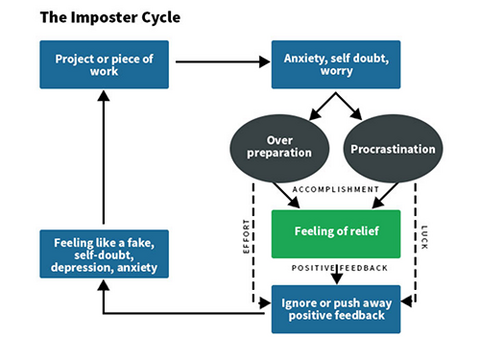The impacts of imposter phenomenon on students and employees in higher education has been the focus of concern (and research) for some time. But, in recent years, the narrative has begun to change. This month, we will explore the evolution of this complex issue.
Where it Started
In 1978, Clance and Imes coined the term imposter phenomenon to describe “an internal experience of intellectual phoniness that appears to be particularly prevalent and intense among a select sample of high achieving women” (p. 241). While women and other equity seeking groups often have higher instances of IP, Bravata, et al.’s 2020 systematic review of IP research showed that up to 82% of people experience IP at some point in their lives. IP was present in individuals across all age groups from adolescents to late-stage professionals, as well as in individuals across a variety of employment types and income levels. IP is especially present in high-achieving individuals. Given that post-secondary institutions are filled with driven, high achieving people, it makes sense that the prevalence and impacts of IP in academia have been a cause for concern.
While most of the research on IP in academia has focused on faculty and students, especially early career faculty and grad students, a 2020 survey showed that 90% of post-secondary educational developers (staff role) also experienced imposterism. The most common reason given was the lack of “official” credentials (Rudenga & Gravett).

Figure 1. The Imposter Phenomenon cycle (Clance et al., 1995).
What is Imposter Phenomenon?
Despite the fact that it is sometimes referred to as imposter "syndrome", IP is not a diagnosable condition (VeryWellMind, n.d.). It is actually considered a psychological behavioral pattern. While most of us experience moments of self-doubt and question our abilities from time to time, especially in new situations, IP is characterized by pervasive feelings of fraudulence. This goes beyond self-doubt to feeling that one is faking it, is a fraud, or that one’s accomplishments were the result of chance or luck and are undeserved. This can result in the downplaying of positive feedback, and/or fears that sooner or later others will discover the truth (see Figure 1. The Imposter Phenomenon Cycle).
Causes of IP are attributed to the interaction of complex factors, including gender, race, family up-bringing, the pressure to achieve, fear of failure (or success), new role/transition where you lack experience and expertise, low self-efficacy (belief in yourself), perfectionism, social anxiety, the need to be the best, levels of support and more (VeryWellMind, n.d.).
IP has been linked to burnout, depression, anxiety, and other health related issues as well as loss of job satisfaction, impaired job performance (Bigatti, 2020). IP has also been shown to impede career advancement, erode sense of belonging (in a field, domain, or organization) and even contributed to decisions to leave the academy (Chakraverty, 2022a,b). IP can also impact working conditions by contributing to workplace harassment (Chakraverty and Rishi, 2022); racial discrimination (Bernard et al., 2018; Chakraverty, 2020, 2022a,b,c,d); hypercompetitive learning environments (Canning et al., 2020); and the underrepresentation of women, first-generation learners, and scholars of color in academia (Pulliam and Gonzalez, 2018; Stone et al., 2018; Vaughn et al., 2019; Canning et al., 2020; Chakraverty, 2022a,b,c,d).
Managing Imposter Phenomenon
Numerous strategies are recommended for addressing feelings of imposterism. Intrinsic approaches include addressing perfectionism, sharing your experiences with others, disconnecting your worth from your accomplishments, focusing on the process rather than the outcome and resisting the urge to compare yourself with others. Sharing your feelings with others and finding a mentor who can provide you with accurate feedback can also be helpful. Multiple therapeutic techniques such as challenging negative thoughts (CBT), gratitude practices, and radical acceptance have also shown to be helpful (Chapman & Kennette, 2021; VeryWellMind, n.d.).
Extrinsic approaches include addressing external factors such as workplace culture, societal expectations, team dynamics, institutional processes that contribute to feelings of isolation or reduce sense of belonging, accessibility, and equity (Chapman & Kennette, 2021).
The Changing Narrative Around Imposter Phenomenon
Historically, IP has focused on the individual and approached addressing IP by assisting the individual to challenge their thoughts, address their perceptions, and receive positive feedback. More recently, the dialogue has shifted to explore the context in which IP occurs. An article published by Diverse: Issues in Higher Education suggests that labeling these feelings as imposter phenomenon can have damaging consequences. People are often told they have imposter syndrome without considering the underlying reasons people feel like an imposter.
In 2021, Harvard Business Review ran an article, Stop Telling Women They Have Imposter Syndrome, which suggested that Clance and Imes original work, which was completed with a primarily white participant group, did not account for the affect of systemic bias, bullying, and exclusion, on sense of belonging and perceptions of personal competence. The original work did not account for how systemic racism, classism, sexism, ageism, and other biases contributed to feeling that one does not fit in, discomfort, second-guessing, and mild anxiety.
Similarly, Jo-Anne Barry in an interview for Ascend magazine, says that imposter phenomenon is a “faux medical diagnosis for women to explain away the chronic discrimination that we’ve experienced.”
In her TedTalk, Dr. Catherine Harmon (MD) says that continuing to show up when the deck is stacked against you, continuing to grow and learn and endure in the face of adversity, has another name: bravery.
Dr. Harmon further suggests that next time you, or your students and colleagues say they feel like a fake, instead of telling that they may have imposter phenomenon, try reminding them how brave they are.